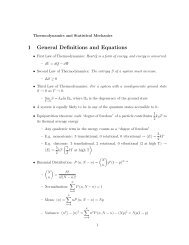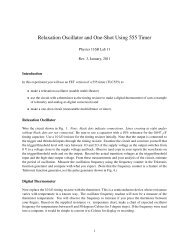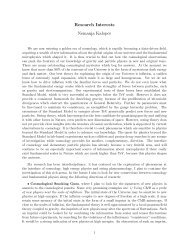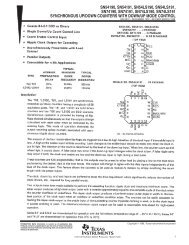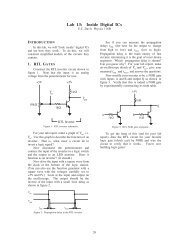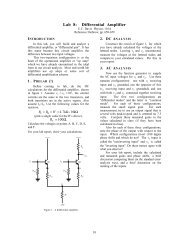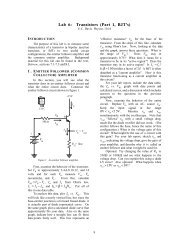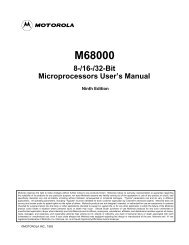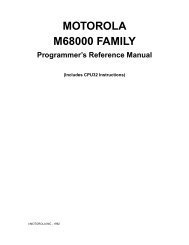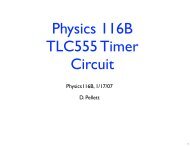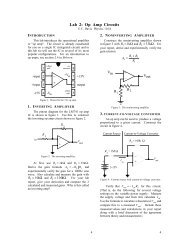Product Description
Product Description
Product Description
Create successful ePaper yourself
Turn your PDF publications into a flip-book with our unique Google optimized e-Paper software.
Order this document by<br />
M68060/D<br />
Microprocessor and Memory<br />
Technologies Group<br />
<strong>Product</strong> Brief<br />
Superscalar 32-Bit Microprocessors<br />
MC68060<br />
MC68LC060<br />
MC68EC060<br />
The superscalar M68060 represents a new line of Motorola microprocessor products. The first generation of the<br />
M68060 product line consists of the MC68060, MC68LC060, and MC68EC060. All three microprocessors offer<br />
superscalar integer performance of over 100 MIPS at 66 MHz. The MC68060 comes fully equipped with both a<br />
floating-point unit (FPU) and a memory management unit (MMU) for high-performance embedded control and<br />
desktop applications. For cost-sensitive embedded control and desktop applications where an MMU is required,<br />
but the additional cost of a FPU is not justified, the MC68LC060 offers high performance at a low cost.<br />
Specifically designed for low-cost embedded control applications, the MC68EC060 eliminates both the FPU and<br />
MMU, permitting designers to leverage MC68060 performance while avoiding the cost of unnecessary features.<br />
Throughout this product brief, all references to the MC68060 also refer to the MC68LC060 and the<br />
MC68EC060, unless otherwise noted. Figure 1 illustrates a block diagram of the MC68060.<br />
EXECUTION UNIT<br />
INSTRUCTION FETCH UNIT<br />
BRANCH<br />
CACHE<br />
INSTRUCTION<br />
BUFFER<br />
IA<br />
CALCULATE<br />
INSTRUCTION<br />
FETCH<br />
EARLY<br />
DECODE<br />
IAG<br />
IB<br />
IC<br />
IED<br />
INSTRUCTION<br />
ATC<br />
INSTRUCTION<br />
CACHE<br />
CONTROLLER<br />
INSTRUCTION<br />
CACHE<br />
INSTRUCTION MEMORY UNIT<br />
B<br />
U<br />
S<br />
ADDRESS<br />
FLOATING-<br />
POINT<br />
UNIT<br />
EA<br />
FETCH<br />
FP<br />
EXECUTE<br />
pOEP<br />
DECODE<br />
DATA AVAILABLE<br />
INTEGER UNIT<br />
DECODE<br />
EA AG EA AG<br />
CALCULATE<br />
CALCULATE<br />
OC<br />
EX<br />
EA<br />
FETCH<br />
INT<br />
EXECUTE<br />
OC<br />
EX<br />
EA<br />
FETCH<br />
INT<br />
EXECUTE<br />
OC<br />
EX<br />
WRITE-BACK<br />
DS<br />
sOEP<br />
DS<br />
DA<br />
WB<br />
DATA<br />
ATC<br />
DATA<br />
CACHE<br />
CONTROLLER<br />
DATA MEMORY UNIT<br />
DATA<br />
CACHE<br />
C<br />
O<br />
N<br />
T<br />
R<br />
O<br />
L<br />
L<br />
E<br />
R<br />
DATA<br />
CONTROL<br />
OPERAND DATA BUS<br />
This document contains information on a product under development. Motorola reserves the right to change or discontinue this product without notice.<br />
© MOTOROLA, 1994<br />
Figure 1. MC68060 Block Diagram<br />
SEMICONDUCTOR PRODUCT INFORMATION
Leveraging many of the same performance enhancements used by RISC designs as well as providing<br />
innovative architectural techniques, the MC68060 harnesses new levels of performance for the M68000 family.<br />
Incorporating 2.5 million transistors on a single piece of silicon, the MC68060 employs a deep pipeline, dual<br />
issue superscalar execution, a branch cache, a high-performance floating-point unit (MC68060 only), eight<br />
Kbytes each of on-chip instruction and data caches, and dual on-chip demand paging MMUs (MC68060 and<br />
MC68LC060 only). The MC68060 allows simultaneous execution of two integer instructions (or an integer and<br />
a floating-point instruction) and one branch instruction during each clock.<br />
The MC68060 features a full internal Harvard architecture. The instruction and data caches are designed to<br />
support concurrent instruction fetch, operand read, and operand write references on every clock. Separate 8-<br />
Kbyte instruction and 8-Kbyte data caches can be frozen to prevent allocation over time-critical code or data.<br />
The independent nature of the caches allows instruction stream fetches, data-stream fetches, and external<br />
accesses to occur simultaneously with instruction execution. The operand data cache is four-way banked to<br />
permit simultaneous read and write access each clock.<br />
A very high bandwidth internal memory system coupled with the compact nature of the M68000 family code<br />
allows the MC68060 to achieve extremely high levels of performance, even when operating from low-cost<br />
memory such as a 32-bit wide dynamic random access memory system.<br />
Instructions are fetched from the internal cache or external memory by a four-stage instruction fetch pipeline.<br />
The MC68060 variable-length instruction system is internally decoded into a fixed-length representation and<br />
channeled into an instruction buffer. The instruction buffer acts as a FIFO which provides a decoupling<br />
mechanism between the instruction fetch unit and the operand execution units. Fixed format instructions are<br />
dispatched to dual four-stage pipelined RISC operand execution engines where they are then executed.<br />
The branch cache also plays a major role in achieving the high performance levels of the MC68060. It has<br />
been implemented such that most branches are executed in zero cycles. Using a technique known as branch<br />
folding, the branch cache allows the instruction fetch pipeline to detect and change the instruction prefetch<br />
stream before the change of flow affects the instruction execution engines, minimizing the need for pipeline<br />
refill.<br />
In addition to substantial cost and performance benefits, the MC68060 also offers advantages in power<br />
consumption and power management. The MC68060 automatically minimizes power dissipation by using a<br />
fully-static design, dynamic power management, and low-voltage operation. It automatically powers-down<br />
internal functional blocks that are not needed on a clock-by-clock basis. Explicitly, the MC68060 power<br />
consumption can be controlled from the operating system. Although the MC68060 operates at a lower<br />
operating voltage, it directly interfaces to both 3-V and 5-V peripherals and logic.<br />
Complete code compatibility with the M68000 family allows the designer to draw on existing code and past<br />
experience to bring products to market quickly. There is also a broad base of established development tools,<br />
including real-time kernels, operating systems, languages, and applications, to assist in product design. The<br />
functionality provided by the MC68060 makes it the ideal choice for a range of high-performance embedded<br />
applications and computing applications. With M68000 family code compatibility, the MC68060 provides a<br />
range of upgrade opportunities to virtually any existing MC68040 application.<br />
2 MC68060 PRODUCT INFORMATION MOTOROLA
The following is a list of primary featuresof the MC68060:<br />
• Fully User-Code Compatible with MC68040<br />
• Superscalar Implementation of M68000 Architecture<br />
— Dual Integer Instruction Execution Improves Performance<br />
• Branch Cache Reduces Branches to Zero Cycles<br />
• Executes Three Instructions per Clock<br />
• Dual 8-Kbyte On-Chip Caches<br />
— Separate Data and Instruction Caches<br />
— Simultaneous Access<br />
— Data Cache is Four-Way Banked to Allow Read and Write Access on Each Clock<br />
• Bus Snooping<br />
• Independent Instruction and Data Paged MMUs (MC68060 and MC68LC060 Only)<br />
• Full 32-Bit Nonmultiplexed Address and Data Bus<br />
— Optimized to Achieve Very High Performance Using 32-Bit Memory System<br />
— Can Operate Bus at 1/2-or 1/4-Speed of Internal Clock<br />
— 32-Bit Bus Maximizes Data Throughput<br />
— Nonmultiplexed Bus Simplifies Design<br />
— Four-Deep Store Buffer and One-Deep Push Buffer to Maximize Write Bandwidth<br />
— MC68040-Compatible Bus Provides Simple Hardware Migration Path<br />
• Power Management<br />
— Automatic Power-Down of Unused Blocks of Logic on a Clock-by-Clock Basis<br />
— Low-Voltage Operation at 3.3 V, with 3.3-V and 5-V I/O Capability<br />
— LPSTOP Mode Provides an Idle State for Lowest Standby Current<br />
— Static CMOS Technology Reduces Power in Normal Operation<br />
• IEEE-Compatible On-Chip FPU (MC68060 Only)<br />
• Available in 40-MHz (MC68EC060 only), 50-MHz, and 66-MHz Speeds<br />
• Packaging<br />
— Ceramic Pin Grid Array (PGA)<br />
— Ceramic Quad Flat Pack (CQFP) (THIS PACKAGE NOT AVAILABLE 3/25/98)<br />
MOTOROLA MC68060 PRODUCT INFORMATION 3
MC68060 SIGNALS<br />
Figure 2 shows the MC68060 functional signal groups.<br />
ADDRESS BUS<br />
AND CONTROL<br />
DATA BUS<br />
A31–A0<br />
CLA<br />
D31–D0<br />
SNOOP<br />
BR<br />
BG<br />
BGR<br />
BB<br />
BTT<br />
BUS SNOOP CONTROL<br />
BUS ARBITRATION<br />
CONTROL<br />
TRANSFER<br />
ATTRIBUTES<br />
TT1<br />
TT0<br />
TM2<br />
TM1<br />
TM0<br />
TLN1<br />
TLN0<br />
UPA1<br />
UPA0<br />
R/W<br />
SIZ1<br />
SIZ0<br />
LOCK<br />
LOCKE<br />
CIOUT<br />
BS0<br />
BS1<br />
BS2<br />
BS3<br />
MC68060<br />
CDIS<br />
MDIS<br />
RSTI<br />
RSTO<br />
IPL2<br />
IPL1<br />
IPL0<br />
IPEND<br />
AVEC<br />
PST4<br />
PST3<br />
PST2<br />
PST1<br />
PST0<br />
CLK<br />
CLKEN<br />
PROCESSOR <br />
CONTROL<br />
INTERRUPT <br />
CONTROL<br />
STATUS AND <br />
CLOCKS<br />
MASTER<br />
TRANSFER<br />
CONTROL<br />
TS<br />
TIP<br />
SAS<br />
JTAG<br />
TCK<br />
TMS<br />
TDI<br />
TDO<br />
TRST<br />
TEST<br />
SLAVE<br />
TRANSFER<br />
CONTROL<br />
TA<br />
TRA<br />
TEA<br />
TBI<br />
TCI<br />
THERM1<br />
THERM0<br />
V CC<br />
GND<br />
THERMAL RESISTOR<br />
CONNECTIONS<br />
POWER SUPPLY<br />
Figure 2. Functional Signal Groups<br />
4 MC68060 PRODUCT INFORMATION MOTOROLA
EXECUTION UNIT<br />
The MC68060 execution unit carries out logical and arithmetic operations. The execution unit contains an<br />
instruction fetch unit, an integer unit, a branch cacheand a floating-point unit. The superscalar design of the<br />
MC68060 provides dual execution pipelines in the instruction integer unit, providing simultaneous instruction<br />
execution.<br />
The superscalar operation of the execution unit can be disabled in software, turning off the second execution<br />
pipeline for debugging. Disabling the superscalar operation also lowers power consumption.<br />
INSTRUCTION FETCH UNIT<br />
The instruction fetch unit contains an instruction fetch pipeline and the logic that interfaces to the branch cache.<br />
The instruction fetch pipeline consists of four stages, providing the ability to prefetch instructions in advance<br />
of their actual use in the instruction execution controller. The continuous fetching of instructions keeps the instruction<br />
execution unit busy for the greatest possible performance. Every instruction passes through each of<br />
the four stages before entering the integer unit. The four stages in the instruction fetch pipeline are:<br />
1) Instruction Address Calculation—The virtual address of the instruction is determined.<br />
2) Instruction Fetch—The instruction is fetched from memory.<br />
3) Early Decode—The instruction is pre-decoded into a fixed length format for pipeline control information.<br />
4) Instruction Buffer—The instruction and its pipeline control information are buffered until the<br />
integer execution pipeline is ready to process the instruction.<br />
BRANCH CACHE<br />
The branch cache plays a major role in achieving the performance levels of the MC68060. The concept of the<br />
branch cache is to provide a mechanism that allows the instruction fetch pipeline to detect and change the<br />
instruction stream before the change of flow affects the integer unit.<br />
The branch cache is examined for a valid branch entry after each instruction fetch address is generated in the<br />
instruction fetch pipeline. If a hit does not occur in the branch cache, the instruction fetch pipeline continues to<br />
fetch instructions sequentially. If a hit occurs in the branch cache, indicating a branch taken instruction, the<br />
current instruction stream is discarded and a new instruction stream is fetched starting at the location indicated<br />
by the branch cache.<br />
INTEGER UNIT<br />
The integer unit contains dual integer execution pipelines, interface logic to the FPU (MC68060 only), and<br />
control logic for data written to the data cache and MMU. The superscalar design of the dual integer execution<br />
pipelines provides for simultaneous instruction execution, which allows processing more than one instruction<br />
during each machine clock cycle. The net effect of this is a software-invisible pipeline capable of sustained<br />
execution rates of less than one machine clock cycle per instruction for the M68000 instruction set.<br />
MOTOROLA MC68060 PRODUCT INFORMATION 5
The integer unit control logic pulls an instruction pair from the instruction buffer every machine clock cycle,<br />
stopping only if the instruction information is not available or if an integer execution pipeline hold condition exists.<br />
The six stages in the dual integer execution pipelines are:<br />
1) Instruction Decode—The instruction is fully decoded.<br />
2) Effective Address Calculation—If the instruction calls for data from memory, the location of the data is<br />
calculated.<br />
3) Effective Address Fetch—Data is fetched from the memory location.<br />
4) Integer Execution—The data is manipulated during execution.<br />
5) Data Available—The result is available.<br />
6) Write-Back—The resulting data is written back to on-chip caches or external memory.<br />
The MC68060 is optimized for most integer instructions to execute in one machine clock cycle. If during the<br />
instruction decode stage the instruction is determined to be a floating-point instruction, it will be passed to the<br />
FPU after the effective address fetch stage. If data is to be written to either the on-chip caches or external<br />
memory after instruction execution, the write-back stage holds the data until memory is ready to receive it.<br />
Temporarily holding data in the write-back stage adds to the overall performance of the MC68060 by not<br />
slowing down pipeline operations.<br />
The MC68060 implements practically all of the MC68040 instructions and addressing modes in hardware for<br />
the highest performance. However, to optimize silicon usage, a very few infrequently used integer instructions<br />
are not fully implemented in hardware. These instructions are emulated in software using the M68060SP which<br />
is available free from Motorola. This software package assures full binary compatibility. Since these<br />
instructions appear very infrequently in the instruction stream, software emulation of the instructions provides<br />
no noticeable loss in performance.<br />
FLOATING-POINT UNIT<br />
(MC68060 ONLY)<br />
Floating-point math is distinguished from integer math, which deals only with whole numbers and fixed decimal<br />
point locations. The IEEE-compatible MC68060 FPU computes numeric calculations with a variable decimal<br />
point location. The MC68060 features a built-in FPU that is MC68040 and MC68881/882 compatible.<br />
Consolidating this important function on-chip speeds up overall processing and eliminates the interfacing<br />
overhead associated with external accelerators. The MC68060 FPU operates in parallel with the integer unit.<br />
The FPU performs numeric calculations while the integer unit continues integer processing.<br />
The FPU has been optimized for the most frequently used instructions and data types to provide the highest<br />
possible performance. The FPU can also be disabled in software to reduce system power consumption.<br />
The MC68060 implements the most frequently used M68000 family floating-point instructions, data types, and<br />
data formats in hardware for the highest performance. The remaining instructions are emulated in software<br />
with the M68060SP to provide complete IEEE compatibility. The M68060SP provides the following features:<br />
• Arithmetic and Transcendental Instructions<br />
• IEEE-Compliant Exception Handlers<br />
• Unimplemented Data Type and Data Format Handlers<br />
6 MC68060 PRODUCT INFORMATION MOTOROLA
MEMORY MANAGEMENT UNITS<br />
(MC68060 AND MC68LC060 ONLY)<br />
The MC68060 contains independent instruction and data MMUs. Each MMU contains a cache memory called<br />
the address translation cache (ATC). The full addressing range of the MC68060 is four Gbytes (4,294,967,296<br />
bytes). Even though most MC68060 systems implement a much smaller physical memory, by using virtual<br />
memory techniques, the system can appear to have a full four Gbytes of physical memory available to each<br />
user program. Each MMU fully supports demand-paged virtual-memory operating systems with either 4- or 8-<br />
Kbyte page sizes. Each MMU protects supervisor areas from accesses by user programs and provides write<br />
protection on a page-by-page basis. For maximum efficiency, each MMU operates in parallel with other<br />
processor activities. The MMUs can be disabled for emulator and debugging support.<br />
The 64-entry, four-way, set-associative ATCs store recently used logical-to-physical address translation<br />
information as page descriptors for instruction and data accesses. Each MMU initiates address translation by<br />
searching for a descriptor containing the address translation information in the ATC. If the descriptor does not<br />
reside in the ATC, the MMU performs external bus cycles through the bus controller to search the translation<br />
tables in physical memory. After being located, the page descriptor is loaded into the ATC, and the address is<br />
correctly translated for the access.<br />
INSTRUCTION AND DATA CACHES<br />
Studies have shown that typical programs spend much of their execution time in a few main routines or tight<br />
loops. Earlier members of the M68000 family took advantage of this locality-of-reference phenomenon to<br />
varying degrees. The MC68060 takes further advantage of cache technology with its two, independent, onchip<br />
physical caches, one for instructions and one for data. The caches reduce the processor's external bus<br />
activity and increase CPU throughput by lowering the effective memory access time. For a typical system<br />
design, the large caches of the MC68060 yield a very high hit rate, providing a substantial increase in system<br />
performance.<br />
The autonomous nature of the caches allows instruction-stream fetches, data-stream fetches, and external<br />
accesses to occur simultaneously with instruction execution. For example, if the MC68060 requires both an<br />
instruction access and an external peripheral access and if the instruction is resident in the on-chip cache, the<br />
peripheral access proceeds unimpeded rather than being queued behind the instruction fetch. If a data<br />
operand is also required and it is resident in the data cache, it can be accessed without hindering either the<br />
instruction access or the external peripheral access. The parallelism inherent in the MC68060 also allows<br />
multiple instructions that do not require any external accesses to execute concurrently while the processor is<br />
performing an external access for a previous instruction.<br />
Each MC68060 cache is eight Kbytes and is accessed by physical addresses. The data cache can be<br />
configured as write-through or deferred copyback on a page basis. This choice allows for optimizing the<br />
system design for high performance when deferred copyback is used.<br />
Cachability of data in each memory page is controlled by two bits in the page descriptor. Cachable pages can<br />
be either write-through or copyback, with no write-allocate for misses to write-through pages.<br />
The MC68060 implements a four-entry write buffer that maximizes system performance by decoupling the<br />
integer pipeline from the external system bus. When needed, the write buffer allows the pipeline to generate<br />
writes every clock cycle, even if the system bus runs at a slower speed than the processor.<br />
MOTOROLA MC68060 PRODUCT INFORMATION 7
CACHE ORGANIZATION<br />
The instruction and data caches are each organized as four-way set associative, with 16-byte lines. Each line<br />
of data has associated with it an address tag and state information that shows the line’s validity. In the data<br />
cache, the state information indicates whether the line is invalid, valid, or dirty.<br />
CACHE COHERENCY<br />
The MC68060 has the ability to watch, or snoop, the external bus during accesses by other bus masters,<br />
maintaining coherency between the MC68060 caches and external memory systems. External bus cycles can<br />
be flagged on the bus as snoopable or nonsnoopable. When an external cycle is marked as snoopable, the<br />
bus snooper checks the caches and invalidates the matching data. Although the execution unit and the bus<br />
snooper circuit have access to the on-chip caches, the snooper has priority over the execution unit.<br />
BUS CONTROLLER<br />
The bus is implemented as a nonmultiplexed, fully synchronous protocol that is clocked off the rising edge of<br />
the input clock. It is compatible with an MC68040 bus. The bus controller operates concurrently with all other<br />
functional units of the MC68060 to maximize system throughput. The timing of the bus is fully configurable to<br />
match external memory requirements.<br />
The CLKEN input is used on the MC68060 to enable to the clock edges on which the bus controller will<br />
respond. By toggling the CLKEN pin, it is possible to operate the MC68060 on an external bus at 1/2 or 1/4<br />
the speed of the processor clock.<br />
Although the MC68060 bus is compatible with the MC68040, additional signals and protocols have been<br />
added to simplify designs requiring very high bus speeds.<br />
IEEE 1149.1 TEST<br />
To aid in system diagnostics, the MC68060 includes dedicated user-accessible test logic that is fully compliant<br />
with the IEEE 1149.1 standard for boundary scan testability, often referred to as Joint Test Action Group<br />
(JTAG).<br />
8 MC68060 PRODUCT INFORMATION MOTOROLA
POWER MANAGEMENT<br />
The MC68060 is very power efficient due to the static logic and power management designed into the basic<br />
architecture. Each stage of the integer unit pipelines and the FPU pipeline draws power only when an<br />
instruction is executing, and the cache arrays draw power only when an access is made. The FPU, secondary<br />
integer execution pipeline, branch cache, and instruction and data caches can be disabled to reduce overall<br />
power usage. The 3.3-V power supply reduces current consumption by 40–60% over that of microprocessors<br />
using a 5-V power supply.<br />
The MC68060 has additional methods for dynamically controlling power consumption during operation.<br />
Running a special LPSTOP instruction shuts down the active circuits in the processor, halting instruction<br />
execution. Power consumption in this standby mode is greatly reduced. Processing can be resumed by<br />
resetting the processor or by generating an interrupt. The frequency of operation can be lowered to reduce<br />
current consumption while the device is in LPSTOP mode.<br />
PHYSICAL<br />
The MC68060 is available in ceramic PGA and CQFP packaging configurations. All parts operate from a<br />
3.3 V 5% power supply but directly interface to 3.3 V or 5 V peripherals and logic. The following table identifies<br />
the operating frequencies available for the various M68060 microprocessors.<br />
Processor 40 MHz 50 MHz 66 MHz<br />
MC68060 X X<br />
MC68LC060 X X<br />
MC68EC060 X X X<br />
The documents listed in the following table contain detailed information on the MC68060. These documents<br />
may be obtained from the Literature Distribution Centers at the addresses listed on the back page.<br />
QFP PACKAGING IS NOT AVAILABLE<br />
Document Title Order Number Contents<br />
M68060 User's Manual M68060UM/AD Detailed information for design<br />
M68000 Family Programmer's Reference Manual M68000PM/AD M68000 Family Instruction Set<br />
The 68K Source BR729/D Independent vendor listing supporting<br />
software and development tools<br />
3.3 Volt Logic and Interface Circuits BR1407/D Low voltage interface components<br />
MOTOROLA MC68060 PRODUCT INFORMATION 9
Motorola reserves the right to make changes without further notice to any products herein. Motorola makes no warranty, representation or guarantee regarding<br />
the suitability of its products for any particular purpose, nor does Motorola assume any liability arising out of the application or use of any product or circuit, and<br />
specifically disclaims any and all liability, including without limitation consequential or incidental damages. "Typical" parameters can and do vary in different<br />
applications. All operating parameters, including "Typicals" must be validated for each customer application by customer's technical experts. Motorola does not<br />
convey any license under its patent rights nor the rights of others. Motorola products are not designed, intended, or authorized for use as components in systems<br />
intended for surgical implant into the body, or other applications intended to support or sustain life, or for any other application in which the failure of the Motorola<br />
product could create a situation where personal injury or death may occur. Should Buyer purchase or use Motorola products for any such unintended or<br />
unauthorized application, Buyer shall indemnify and hold Motorola and its officers, employees, subsidiaries, affiliates, and distributors harmless against all claims,<br />
costs, damages, and expenses, and reasonable attorney fees arising out of, directly or indirectly, any claim of personal injury or death associated with such<br />
unintended or unauthorized use, even if such claim alleges that Motorola was negligent regarding the design or manufacture of the part. Motorola and µ are<br />
registered trademarks of Motorola, Inc. Motorola, Inc. is an Equal Opportunity/Affirmative Action Employer.<br />
Literature Distribution Centers:<br />
USA: Motorola Literature Distribution; P.O. Box 20912, Arizona 85036.<br />
EUROPE: Motorola Ltd.; European Literature Centre; 88 Tanners Drive, Blakelands, Milton Keynes, MK14 5BP, England.<br />
JAPAN: Nippon Motorola Ltd.; 4-32-1, Nishi-Gotanda, Shinagawa-ku, Tokyo 141 Japan.<br />
ASIA-PACIFIC: Motorola Semiconductors H.K. Ltd.; Silicon Harbour Center, No. 2 Dai King Street, Tai Po Industrial Estate,<br />
Tai Po, N.T., Hong Kong.<br />
SEMICONDUCTOR PRODUCT INFORMATION



